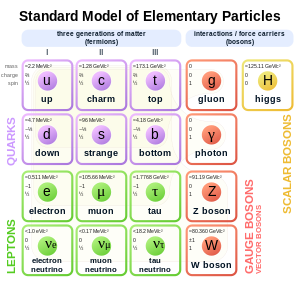
Back Elementêre deeltjie Afrikaans Elementarteilchen ALS Particla elemental AN جسيم أولي Arabic Partícula elemental AST Elementar hissəcik Azerbaijani بنیادی ذرهلر AZB Elementaraitzal BAR Элементарная часціца Byelorussian Элемэнтарная часьцінка BE-X-OLD

1 GeV/c2 = 1.783x10-27 kg. 1 MeV/c2 = 1.783x10-30 kg.
In physics, an elementary particle or fundamental particle is a particle that is not made of other particles.
An elementary particle can be one of two groups: a fermion or a boson. Fermions are the building blocks of matter and have mass, while bosons behave as force carriers for relations between fermion and some of them have no mass.[1] The Standard Model is the most accepted way to explain how particles behave, and the forces that affect them. According to this model, the elementary particles are further grouped into quarks, leptons, and gauge bosons, with the Higgs boson having a special status as a non-gauge boson.
Of the particles that make up an atom, only the electron is an elementary particle. Protons and neutrons are each made of 3 quarks, which makes them composite particles, particles that are made of other particles. The quarks are bound together by the gluons. The nucleus has boson pion fields responsible for the strong nuclear force binding protons and neutrons against the electrostatic repulsion between protons. Such virtual pions are composed of quark antiquark pairs again held together by gluons.
There are three basic properties that describe an elementary particle: ’mass’, ’charge’, and ’spin’. Each property is assigned a number value. For mass and charge the number can be zero. For example, a photon has zero mass and a neutrino has zero charge. These properties always stay the same for an elementary particle.
- Mass: A particle has mass if it takes energy to increase its speed, or to accelerate it. The table to the right gives the mass of each elementary particle. The values are given in MeV/c2s (that is pronounced megaelectronvolts over "c" squared), that is in units of energy over the speed of light squared. This comes from special relativity, which tells us that energy equals mass times the square of the speed of light. All particles with mass produce gravity. All particles are affected by gravity, even particles with no mass like the photon (see general relativity).
- Electric charge: Particles may have positive charge, or negative, or none. If one particle has a negative charge, and another particle has a positive charge, the two particles are attracted to each other. If the two particles both have negative charge, or both have positive charge, the two particles are pushed apart. At short distances, this force is much stronger than the force of gravity which pulls all particles together. An electron has charge -1. A proton has charge +1. A neutron has an average charge 0. Normal quarks have charge of ⅔ or -⅓.
- Spin: The angular momentum or constant turning of a particle has a particular value, called its spin number. Spin for elementary particles is one or ½. The spin property of particles only denotes the presence of angular momentum. In reality, the particles do not spin.
Mass and charge are properties we see in everyday life, because gravity and electricity affect things that humans see and touch. But spin affects only the world of subatomic particles, so it cannot be directly observed.
- ↑ Sylvie Braibant; Giorgio Giacomelli; Maurizio Spurio (2012). Particles and fundamental interactions: an introduction to particle physics (2nd ed.). Springer. pp. 1–3. ISBN 978-94-007-2463-1.
© MMXXIII Rich X Search. We shall prevail. All rights reserved. Rich X Search